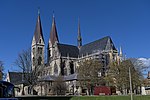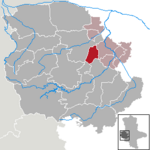Halberstadt

Halberstadt (Eastphalian: Halverstidde) is a town in the German state of Saxony-Anhalt, the capital of Harz district. Located north of the Harz mountain range, it is known for its old town center, which was largely destroyed by Allied bombings in the late stages of World War II after local Nazi leaders refused to surrender. The town was rebuilt in the following decades. In World War I Halberstadt was the site of a German military airbase and aircraft-manufacturing facilities. In World War II Halberstadt was a regional production center for Junkers aircraft, which also housed an SS forced labor camp. Halberstadt now includes the area where the Langenstein-Zwieberge concentration camp was situated.
Excerpt from the Wikipedia article Halberstadt (License: CC BY-SA 3.0, Authors, Images).Halberstadt
Domplatz,
Geographical coordinates (GPS) Address Nearby Places Show on map
Geographical coordinates (GPS)
| Latitude | Longitude |
|---|---|
| N 51.895833333333 ° | E 11.046666666667 ° |
Address
Domplatz 41
38820 (Halberstadt)
Saxony-Anhalt, Germany
Open on Google Maps









